The Nazis had a unique approach to keeping the masses in check. They knew how to unite people under their flag and how businesses use the same methodology to persuade people to buy their services.
They were ahead of their time in the art of persuasion, and the strategies that they employed were later recognized worldwide. The same methods are now being used in marketing.
In Part 1 of the Nazi Marketing in Society series, we investigated if there was a Nazi Brand and its characteristics. In this second part, we’re going to cover in more detail the Nazi Marketing strategy, methodology and also their output.
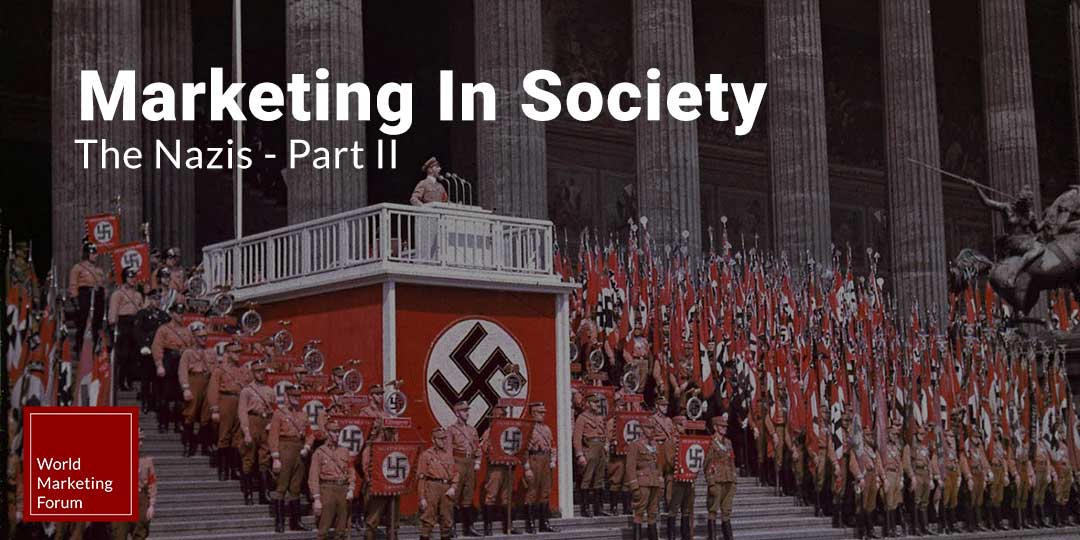
Source: Vitag.es
What the nazis intended was not something that was the first of its kind. Religious advocates had been trying to accomplish the same thing for several decades. They wanted to instil new beliefs in their people. The Nazis had understood this truth, which is the importance of communication, and thus they devised, or more often, just copied communication strategies.
At this point, the marketing strategies were only limited to sales. Marketing, which was the art of generating a public image of a product or a service, was limited to only the businesses that used them. Nazis also used advanced marketing tactics like targeted marketing, direct mails, relationship marketing, and segmentation. They used these techniques to spread their agenda to the masses.
They researched different classes of people living at the time and delivered their propaganda in a relatable manner. To achieve this the Nazis partnered with IBM. Yes, that IBM, the American computer company, helped the Nazis in many ways.
Nazi Marketing Strategy
Franz Neumann claimed that the success of Nazi Nationalists was due to the transformation of their culture into a saleable product.
They converted their culture into a commodity and then left no stone unturned in marketing that commodity to the public in every way they could find. Similarly, Karl Bracher said that even if Nazis’ political ideas and socialist programmes had been refused by the unbiased, their mastery of slogans and efficient propaganda successfully appealed to the public emotions.
Most of their decisions were not based on some strict rule that they had to follow. They did not have a “holy book” of rules and strategies. In fact, more often than not, they made important decisions, foreign policies, and laws as they went. They improvised their plays on the spot. Nothing was off bound to them, but one thing they never missed was their attention to detail.
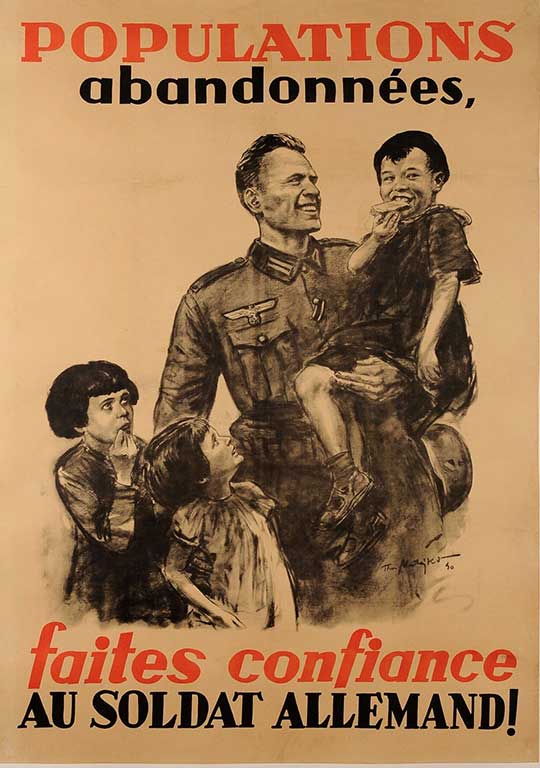
Circa 1940’s: French poster to foster trust and integration among the french population
Seizing the Opportunity
Nazis were masters of communication with the public.
They did not miss any opportunity to spread their propaganda. Most of their strategies were inspired by the rules of a street fight. Basic and straightforward. They spread written and oral riposte left and right as firm believers of the compounding effect.
They believed that small things like this would ultimately have a big reward or at least it will disrupt their rivals. Whether it was their local rivals or international enemies, they used the same tactics to repel everyone.
The Nazis were cunning tacticians, but their strategies lacked depth. They used deceit to represent themselves as a revolutionary organization and decided the worth of tools based on their utility rather than morality.
They judged everything at face value. They had their eyes only on the ultimate price, and it did not bother them to use any means they could to get there.
Their biggest inspiration was the Italian fascists, but unlike them, the Nazis were more determined and successful in their propaganda. Their use of force, persuasion, violence, and deceit mixed with pseudo-legal means resulted in their gradual success.
Their determination and consistent effort were what made them the Nazis we remember in historical records.
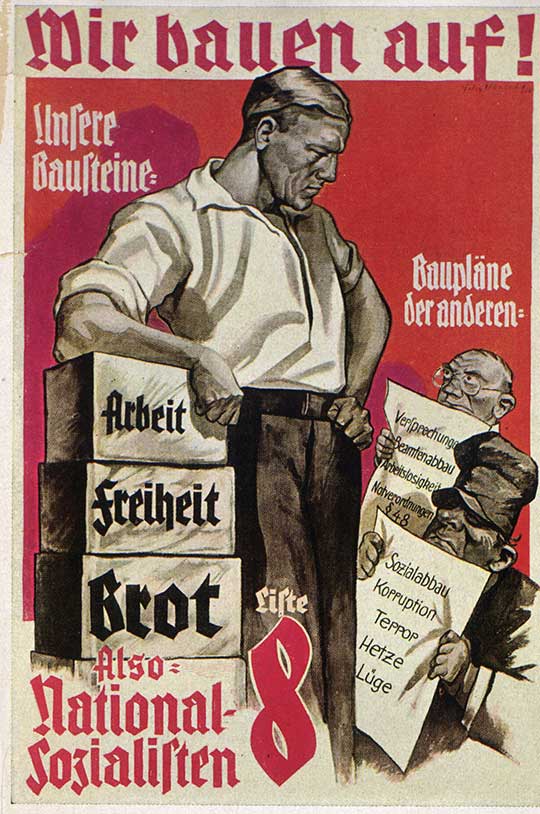
Circa 1930: A nazi propaganda poster offering work, freedom and bread as opposed to the empty promises of their opponents
Nazi Marketing Methodology
The Nazis offered the promise of a dreamy utopia, communicated to the people with intelligent wordplay. They wanted people to believe that they were striving for a heaven on earth. This idea was preached in their printed media that came in all forms. As mentioned earlier, their forte was their attention to detail. Their special propaganda groups are a perfect example of this, but we’ll talk about that in a bit. So, although their printed circulars were consistent, there was always room for interpretation that was left intentionally.
An example can be seen by this poster besides this paragraph.
Their propaganda machine was always on the move. There were regular monthly circulars that were provided consistently. There were comprehensive catalogues of leaflets and pamphlets with lists of speakers and their topics used as guidelines for their followers. There were even instructions for specific individual needs. Both films and slide shows were aired in many places.
Of course, all of this media was keenly observed by the national headquarters, in Munich.
The followers were ordered to manage their expectations and behave according to instructions. The Nazis ordered their followers to avoid calling any slide show a ‘film.’ Perhaps one of the most interesting pieces of ultra-specific advice was about considering the saliva emission of the public.
- The Nazis used their party stickers everywhere and incessantly put them on display.
- They thought the stickers should be small enough so that ordinary people have enough saliva to apply them quickly.
- The stickers should have a good layout that is easy to understand and recognize.
- There should be no white space at the edges to make a place for graffiti.
- All party members were ordered to carry the stickers everywhere and give them out to as many people as possible.
The purpose of these stickers was more interesting than their manufacturing conditions.
The Nazis believed in the power of constant repetition.
This belief translated into their stickers as they were ‘a constant reminder to the indifferent and gradually unsettle them, since “many drops wear away stone” … Incessantly, repeatedly, people must see our stickers!’
Their attention was always on the operational details. One example is their need for a unique group of trained propagandists skilled in hanging posters. They say that one of the critical aspects of a successful spread of agenda is using means that are especially hard to remove. Using a glass pane as a base also works wonders, as well as using multiple stickers side by side as, according to them, ‘identical stickers next to each other make a good effect.’
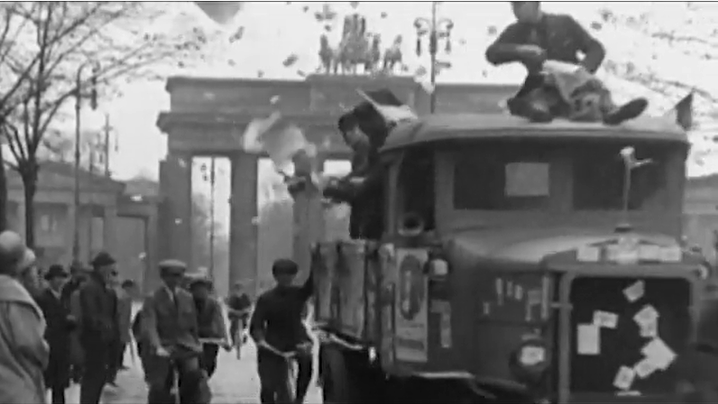
Nazis giving out their stickers. Photo Courtesy: Britannica
The Nazis Learning Mindset
The Nazis did not come up with all of these foolproof strategies on their own either. They had a lot of examples to learn from. They had a working example of establishing and sustaining a propaganda base, the Communists’ model, and they were not new to the concept either. Nazis were not above learning a thing or two from their rivals whenever they got a chance. They even adopted a modified version of some strategies and copied others altogether.
Whether it was the British in the trenches, the Communists in the streets, or the Bolsheviks, they absorbed whatever they saw fit and made it their own.
The Bolsheviks taught them the importance of;
- Discipline
- Timely action
- Organization
- And perhaps most importantly, slogans.
They also learned the value of controlling the crowd. You win the game if you hold the public’s perspective and opinion, and the Nazis were great at it through the excessive repetition of their ideals.
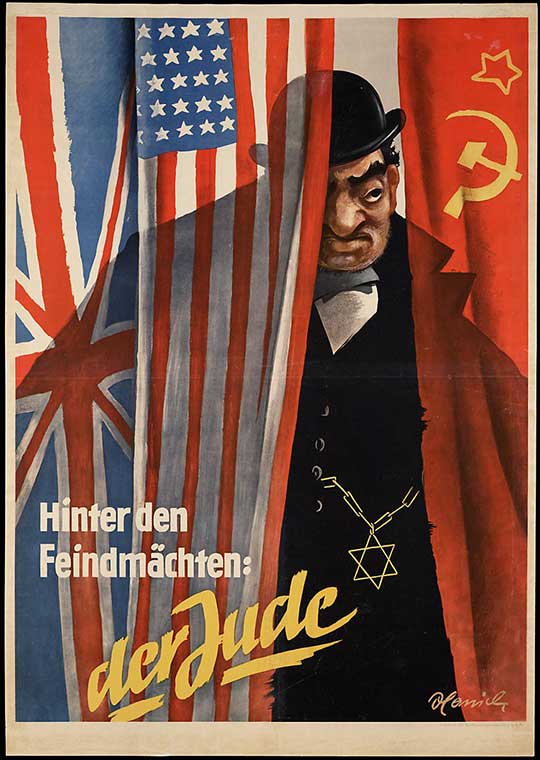
Nazi propaganda poster that reads “Behind the enemy powers: The Jews”
From others, they borrowed particular methods – hence their emphasis on the “neighbourhood newspaper.” Then there was a “factory newspaper,” specially made for each factory. And all of these were supervised by the capital as well.
The Nazis were like omnivorous predators, pillaging and taking from a rich source of cultures and using it as their own. However, the Nazis were not the first of their kind, i.e., a highly organized post-war ultra-nationalist party. An example to learn from was the German Racial Defense and Defiance.
Richard J. Evans wrote, “it ran a sophisticated propaganda machine, churning out millions of leaflets and putting meetings where the public numbered thousands rather than the hundreds which Drexler’s organization was able to attract.”
The Nazi propagandists were well trained, and this was not born out of luxury but necessity, as their goals were not for inspired amateurs. There was no magical reservoir of people that Nazis could pick from; they had to train their people to do their bidding.
There was no shortage of people willing to get involved either, and the number of individuals involved in spreading their message was mind-boggling. Some did it as a full-time job, and others were just part-timers.
Nazis organized recruitment drives to gather such people to train and use. An example can be seen on the poster beside this paragraph
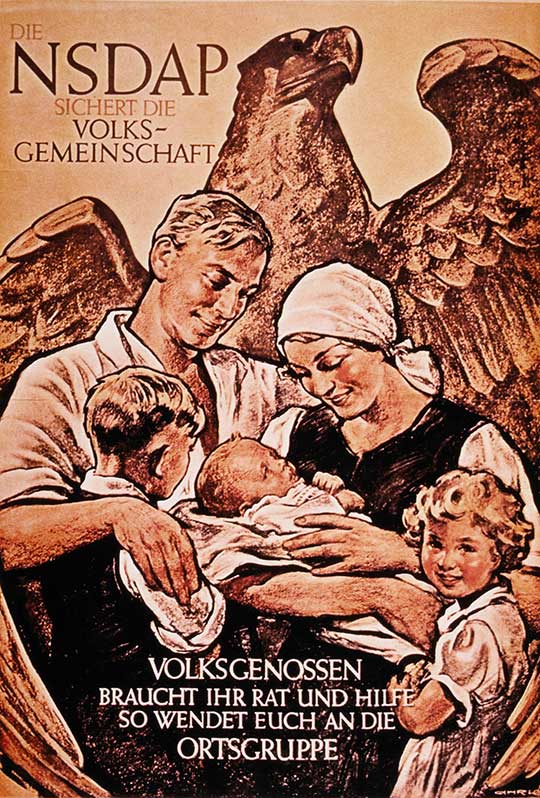
This mid-1930s poster says, “The NSDAP [Nazi Party] protects the people. Your fellow comrades need your advice and help, so join the local party organization
There were special training schools, not only for the speakers but also for the audience, who would then steer the conversation in their desired direction. The trainees memorized standardized texts their trainers provided them and practised in front of a mirror for hours. Their dedication and techniques were more akin to actors than politicians.
They desired to create a prosperous country with more consumer opportunities and a superior standard of living than the United States.

Goebbels – Nazi Propaganda Minister
By the end of 1932, these special training schools had graduated more than 6000 people. There were also incentive systems to reward people for following their guidelines, and the feedback system allowed them to fine-tune their strategy constantly. After their electoral success in July 1932, Hitler proceeded to make a propaganda ministry;
- Hitler chose Joseph Goebbels, the district leader of Berlin and the Nazis’ chief propagandist, as the director of the ‘Propaganda Ministry.’
- Goebbels’ vision translated in the ministry controlling the national schools, films, and radios, putting Germans’ education in his hand.
- Propaganda ministry was a strange idea for a country at peace, but Hitler went on with it.
- The ministry effectively enabled the government to put their ideas into their people’s minds at the grass-root level.
Even after all of this, they understood that there would always be some individuals in community organizations, recreational clubs, or war veterans who could not be won over to participate in their propaganda. So, they organized their events as community-focused as possible to mobilize these organizations that they could not directly order to join with them. They had a subtle solution for everything, and when subtlety did not work, there was always the option of violence.
The ultimate goal was to gather all of Germany under their banner; if a single individual had yet to be converted to Nazism, the party’s work would continue.
The Nazi Sales Force
We have established that the Nazis intuitively used marketing strategies to further their cause, but what was their parallel sales force? That would be the local groups, all of which engaged in propaganda. The party was highly organized, even at a local level.
- There were a total of fourteen regional districts where Nazi propagandists were active.
- Thirty thousand trained propaganda groups were active in these districts marketing the Nazi propaganda using every means at their disposal.
- Fourteen thousand propaganda functionaries were at their disposal to carry out their activities.
These numbers are enormous for a party’s regional activities. Furthermore, these activities could get very intense; for example, in March 1939, there were sixty-two meetings held in a single day.
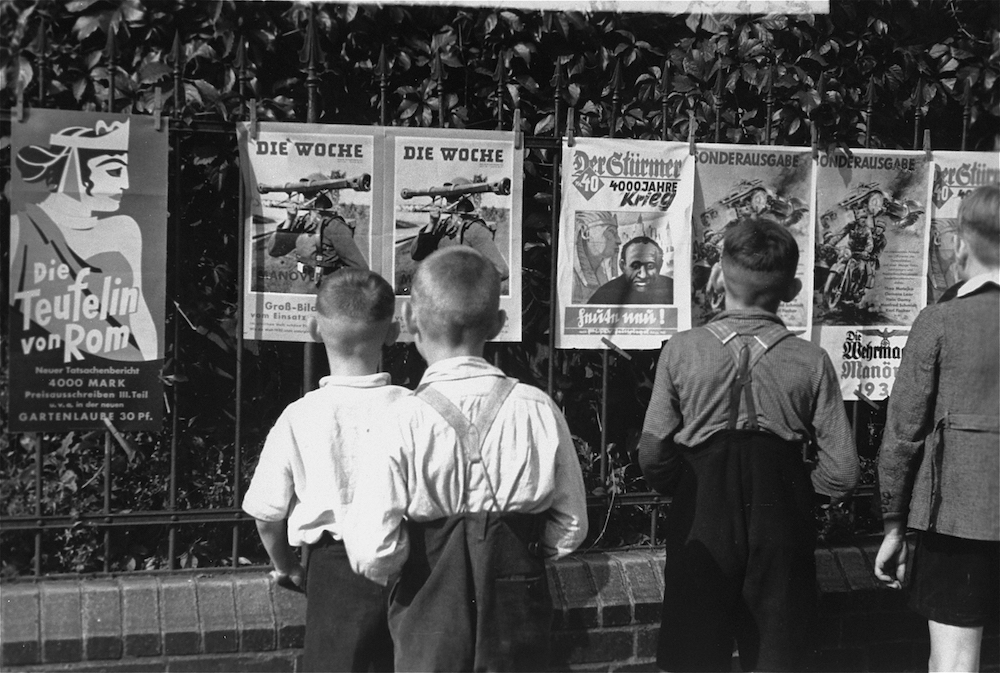
Multiple Nazi propaganda stickers put together. Photo Courtesy: USHMM
Even after putting immense efforts into things, the Nazis were greeted with apathy and lethargy time and again. The common folk was just not interested in doing anything. They didn’t want to be a part of a historical era, nor did they appreciate the sophisticated answer Hitler gave them in response to all of their fears.
The activists said that the most challenging part was inspiring and motivating the people because they were in a constant state of laziness.
It is interesting to note that although the people recognized the swastika, it was challenging to get people to put it on display, even in Germany in 1932!
The party finally assumed power through constant struggle and effort, but this power went to their heads at so many different levels. Different leaders and wardens refused to accept trivial tasks saying that they were not “message boys” anymore. One can argue that this was a reasonable response to the amount of overwork they did, but it was not acceptable to the party.
Pro Tip: Engage your staff in multiple tasks on different spheres and scope so that they maintain the enthusiasm, energy and high output, promote the most dedicated ones to oversee your growing numbers of staff to keep them motivated and engaged. Stagnation and Robotization of tasks will demotivate your staff and decrease output, even if they believe in the mission and are highly devouted.
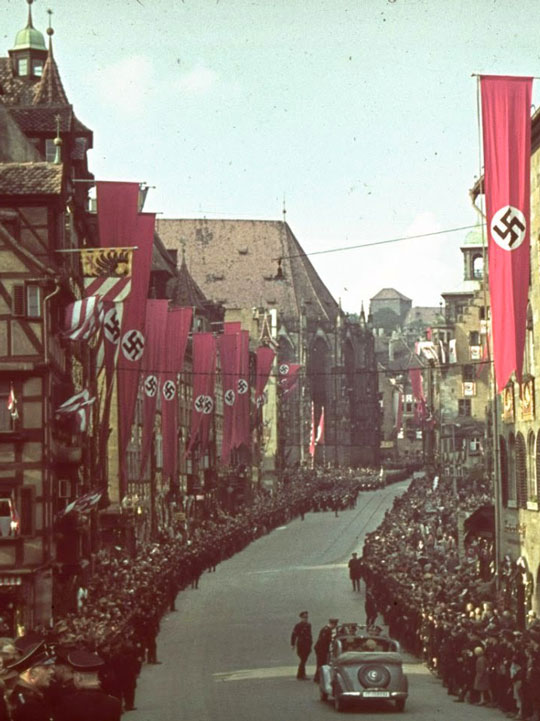
Nazi parade in Nuremberg 1938 Source: Vitag.es
Nazi Marketing Output
The Nazis’ ‘product’ established the importance of propaganda. This importance was due to how expensive it was to publish it, and the industry was highly competitive. But they did not back down and continued with their printed media till the very last second. Even when Berlin was surrounded, Das Reich, the Nazi Propaganda newspaper, was still published.
Nazis devised a new way, i.e., propaganda through mass marches, to which it was said that ‘good discipline is the best propaganda.’ They used every means of propaganda they could find and even used some that were considered unconventional at the time.
- There was a massive overkill in the number of meeting and gathering that the party organized.
- Each party member’s schedule was prepared eight months in advance, and each one had to attend an event every three days. In 1929, they held 1,300 meetings just before the state election in Saxony.
- In 1930, the party held almost 34,000 meetings, a staggering amount compared to their rivals.
- In 1935 alone, 140 propaganda films were published and aired.
- There were 120,000 screenings held for these films, and 21 million visitors came to the shows.
- There were regional offices that sponsored these shows for almost 48,000 villages.
- During wartime, this number became even more staggering; 1,000 films carried by motorized film units did almost 250,000 screenings in different villages reaching an audience of 15 million viewers.
If the parades were business, then the films were a form of pleasure for the members.
Conclusion
After transforming their culture into a brand, the Nazis quickly went on to the next step, which was marketing their brand. They left no stone unturned in the matter either. They had their faith in the power of repetition, and that is precisely what they did.
Every member of their country recognized their swastika. It would not be far from reality to say that people might have seen the symbol in their dreams and unconsciously spread the message to more people, effectively making the entire country a propaganda machine for the Nazis. We should adopt this consistency and determination in our marketing routines as they are historically proven to work.
After establishing a brand and its features as we have seen in Part 1, there comes a fundamental aspect – Distribution! So that we can continue to enforce, repetition, repetition, repetition! Repeat a message, at all times, in all places! Until everyone unconsciously transmits it to others. Dominate the communication channels, don’t spare any effort in communicating, in all channels, at the same time, in a consistent way! We can learn from the Nazis and bring to our companies to boost our Marketing Efforts.


